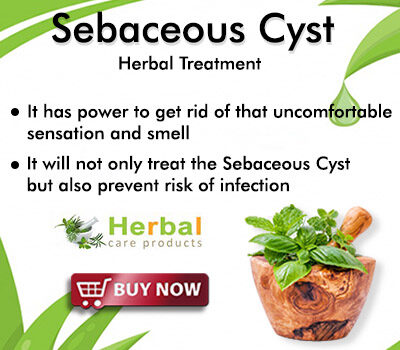Sebaceous Cyst
Sebaceous cysts are typically harmless, slow-growing bumps under the skin. They often appear on the scalp, face, ears, trunk, back, or groin area. They are sometimes called epidermal inclusion cysts. But it’s more accurate to call them sebaceous cysts.
These cysts can occur because of:
- A ruptured follicle linked to acne
- A sebaceous duct that doesn't grow correctly
- Injury to the area
Sometimes they happen for no clear reason. The cysts usually contain keratin, lipid, and other skin particles.
Cysts can remain stable or they may steadily grow. Sometimes they will become inflamed or suddenly break open (rupture). This poses a risk for infection.
Causes
Sebaceous Cysts form out of your sebaceous gland. The sebaceous gland produces the oil (called sebum) that coats your hair and skin.
Cysts can develop if the gland or its duct (the passage from which the oil is able to leave) becomes damaged or blocked. This usually occurs due to a trauma to the area.
The trauma may be a scratch, a surgical wound, or a skin condition, such as acne. Sebaceous cysts grow slowly, so the trauma may have occurred weeks or months before you notice the cyst.
Other causes of a sebaceous cyst may include:
- Misshapen or deformed duct
- Damage to the cells during a surgery
- Genetic conditions, such as Gardner’s syndrome or basal cell nevus syndrome
Symptoms
The main symptom of a sebaceous cyst is a small lump under the skin. The lump is usually not painful. In some cases, however, cysts can get inflamed and become tender to the touch. The skin on the area of the cyst may be red and/or warm. Drainage from the cyst will appear grayish-white and cheese-like, and will have a foul smell.
Treatment
A sebaceous cyst usually does not need to be treated unless it is inflamed (red) or is causing a cosmetic problem. Inflamed cysts usually are treated by draining the fluid and removing the shell that make up the cyst wall. You also may be treated with antibiotics if the skin around the cyst is also inflamed. If a cyst is causing irritation or cosmetic difficulty, your physician can remove it by making a small incision in the skin and emptying the contents of the cyst and its wall.
Herbal Remedies for Sebaceous Cyst
Some people can ask why to use natural home remedies for their problems. There are a range of natural remedies for sebaceous cyst that you can safely use yourself, without knowing very much. Natural remedies to help prevent or cure sebaceous cyst. Natural Remedies for Sebaceous Cyst are mentioned ahead so that you can be more naturally without causing any further damage to the body. Herbal Treatment for Sebaceous Cyst may be just as effective and no any kind of side effects. Most people find that natural remedies for sebaceous cyst work extremely well for them.
Tea Tree Oil
It has good anti-bacterial and anti-inflammatory properties. It’s also soothing in nature and gives a cooling effect. For the treatment of Sebaceous Cyst Tea Tree Oil, apply some tea tree oil directly on it. It will work as a protecting layer for the cyst and will fight against infecting bacteria. It will also reduce the reoccurrence of sebaceous cyst.
Neem Water
Boil six to seven Neem leaves in two glasses of water until only one glass is left. Neem is rich in anti-bacterial properties. Drink this twice daily and the cyst would soon be gone.Try these remedies at home and see if your cyst is cured. If these treatments don’t work, visit your doctor and get a more professional opinion.
Witch Hazel
Witch Hazel for Sebaceous Cyst has astringent properties which clean impurities off the skin and removes excess oil. Tannin from this herb also stops clogging of sebaceous glands.
- Apply witch hazel petals on the sebaceous cyst and let it stay on the cyst for as long as you can.
- Repeat 3 – 4 times a day.
Aloe Vera
Aloe vera has been used for thousands of years as a key ingredient of the alternative herbal medicine. The aloe Vera leaves has strong anti-bacterial properties which speed up healing.
- Cut the aloe vera leaf entirely and save the gel.
- Apply the gel on the cyst and leave it there for 2 – 5 hours.
- Rinse away and reapply once a day.
Potato
Potatoes contain glycoalkaloids with anti-inflammatory benefits. Potatoes can also eliminate microbes from the cyst and help you heal faster.
- Grate a small row potato and save the juice.
- Apply the potato juice on the cyst with a potato slice.
- Cover with a washcloth and leave it overnight.
- Repeat for a few days until healing.
Herbal Care Products are offering “BANICAL” for Sebaceous Cyst Herbal Treatment, it is an herbal supplement made out of 100% natural ingredients for herbal treatment for Sebaceous Cyst that are obtained from authentic herb retailers. It has been particularly formulated for patients suffering from Sebaceous Cyst.
Sources:
https://www.urmc.rochester.edu/encyclopedia/content.aspx?contenttypeid=85&contentid=p00273
https://www.health.harvard.edu/a_to_z/sebaceous-cysts-a-to-z
https://www.healthline.com/health/sebaceous-cyst#causes
https://htv.com.pk/home-remedies/6-home-remedies-to-cure-cysts-2
https://www.naludamagazine.com/10-effective-home-remedies-sebaceous-cyst/
